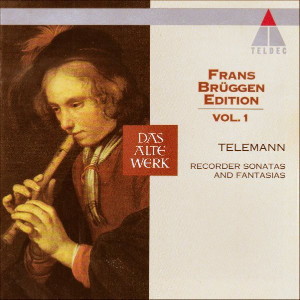 |
|
1 CD -
4509-93688-2 - (c) 1995
|
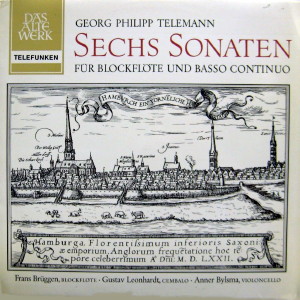
|
| 1 LP -
SAWT 9435-B - (p) 1963 |
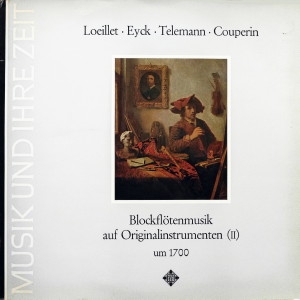 |
| 1 LP -
SAWT 9545-A - (p) 1969 |
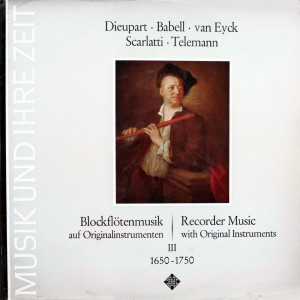 |
| 1 LP -
SAWT 9582-A - (p) 1972 |
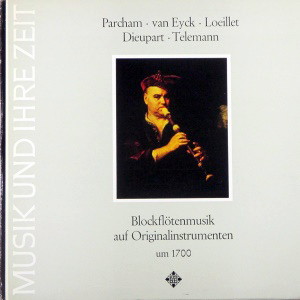 |
| 1 LP -
SAWT 9482-A - (p) 1966 |
|
| FRANS
BRÜGGEN EDITION - Volume 1 |
|
|
|
|
|
| Georg Philipp
Telemann (1681-1767) |
|
|
|
|
|
| Sonata in F major
TWV 41: F2 - from "Der
getreue Musik-Meister" |
5' 51" |
|
| 1.
Vivace |
2'
24" |
|
| 2.
Largo |
1'
50" |
|
| 3.
Allegro |
1'
37" |
|
| Fantasia in D
minor TWV 40: 4 - from "12
Fantaisies ŕ Travers. sans Basse" |
3' 49" |
|
| 4.
Largo |
0'
20" |
|
| 5.
Vivace |
0'
56" |
|
| 6.
Largo |
0'
31" |
|
| 7.
Vivace |
0'
40" |
|
| 8. Allegro
|
1'
22" |
|
| Canonic
sonata in B flat major TWV 41: B3
- from "Der getreue
Musik-Meister" |
6' 41" |
|
| 9. Largo |
1'
29" |
|
| 10. Allegro |
2'
07" |
|
| 11. Largo |
1'
24" |
|
| 12. Vivace |
1'
41" |
|
| Fantasia
in G minor TWV 40: 9 - from "12
Fantaisies ŕ Travers. sans Basse" |
4' 37" |
|
| 13. Largo ·
Spirituoso · Allegro |
|
|
| Sonata
in C major TWV 41: C5 - from "Essercizii
Musici overo Dodedci Soli e Dedeci
Trii ŕ diversi stromenti" |
7' 35" |
|
| 14. Adagio ·
Allegro |
2'
39" |
|
| 15. Larghetto |
2'
01" |
|
| 16. Vivace |
2'
55" |
|
| Fantasia
in A minor TWV 40: 11 - from "12
Fantaisies ŕ Travers. sans
Basse"
|
5' 03" |
|
| 17. A tempo giusto
|
2'
38" |
|
| 18. Presto |
1'
13" |
|
| 19. Moderato |
1'
12" |
|
| Fantasia
in C major TWV 40: 2 - from "12
Fantaisies ŕ Travers. sans
Basse"
|
3' 51" |
|
| 20. Vivace |
2'
34" |
|
| 21. Allegro |
1'
17" |
|
| Sonata
in F minor TWV 41: f1 - from "Der
getreue Musik-Meister" |
10' 36" |
|
| 22. Triste |
2'
32" |
|
| 23. Allegro |
4'
18" |
|
| 24. Andante |
1'
35" |
|
| 25. Vivace |
2'
11" |
|
| Fantasia
in B flat major TWV 40: 12 - from "12
Fantaisies ŕ Travers. sans Basse" |
3' 47" |
|
26. Allegro ·
Adagio · Vivace · Adagio
|
|
|
| Sonata
in D minor TWV 41: d4 - from "Essercizii
Musici overo Dodedci Soli e Dedeci
Trii ŕ diversi stromenti" |
9' 18" |
|
| 27. Affettuoso |
1'
46" |
|
| 28. Presto |
3'
49" |
|
| 29. Grave |
0'
52" |
|
| 30. Allegro |
2'
51" |
|
| Fantasia
in F major TWV 40: 8 - from "12
Fantaisies ŕ Travers. sans
Basse"
|
4' 52" |
|
| 31. Alla francese |
4'
01" |
|
| 32. Presto |
0'
51" |
|
| Sonata
in C major TWV 41: C2 - from "Der
getreue Musik-Meister" |
7' 24" |
|
| 33. Cantabile |
1'
18" |
|
| 34. Allegro |
2'
23" |
|
| 35. Grave |
1'
48" |
|
| 36. Vivace |
1'
55" |
|
|
|
|
| Frans Brüggen, recorder |
|
| Anner Bylsma, violoncello |
|
| Gustav Leonhardt,
harpsichord |
|
|
|
|
|
Luogo
e data di registrazione |
|
-
Doopsgezinde Kerk, Amsterdam
(Olanda) - gennaio & novembre
1971 [13, 26]
- Bennebroek (Olanda) - aprile
& maggio 1969 [4-8, 31-32] |
|
|
Registrazione:
live / studio |
|
studio |
|
|
Producer /
Engineer |
|
Wolf
Erichson [4-8, 13, 26]
|
|
|
Prima Edizione
LP |
|
-
Telefunken "Das Alte Werk" - SAWT
9435-B - (1 LP) - durata 47' 25" -
(p) 1967 - Analogico [1-3, 9-12,
14-16, 22-25, 27-30, 33-36]
- Telefunken "Das Alte Werk" -
SAWT 9545-A - (1 LP) - durata 41'
45" - (p) 1969 - Analogico [4-8,
31-32]
- Telefunken "Das Alte Werk" -
SAWT 9582-A - (1 LP) - durata 52'
43" - (p) 1972 - Analogico [13,
26]
- Telefunken "Das Alte Werk" -
SAWT 9482-A - (1 LP) - durata 48'
01" - (p) 1966 - Analogico [17-19,
20-21]
|
|
|
Edizione CD |
|
Teldec
- 4509-93688-2 - (1 CD) - durata
74' 44" - (c) 1995 - ADD |
|
|
Note |
|
- |
|
|
|
|
Georg Philipp
Telemann, a cosmopolitan
composer who was born in
Magdeburg in 1681 and
died in Hamburg in 1767,
published a set of
multi-movement Fantasias TWV
40:2-13
in 1732
or 1733
as Fantaisies
ŕ
Travers, sans Basse
(the title given in a
contemporary publisher`s
catalogue - the only
surviving printed copy of
the music has an incorrect
title page). The pieces were
in fact written for the
transverse flute. However,
it was not unusual to play
such compositions on the
recorder. In order to do
this it was necessary to
transpose them up a minor
third: the lowest note of
the treble recorder is a
minor third higher than that
of the transverse flute.
Thus the keys on the present
recording are those of the
transposed versions.
A few years before these
fantasias were written,
Telernann published a
biweekly periodical (based
on English models),
Der getreue Music-Meister.
This had twenty-five
instalments, each four pages
in length, and contained
pieces of music instead of
literary texts. The composer
and publisher rather
cleverly encouraged
subscribers to buy the
following instalments by
dividing up multi-movement
pieces between various
issues, just like a
serialized novel. Written
for a wide variety of
scorings, these compositions
were aimed at a rather
heterogeneous middle-class
public that took an interest
in domestic musicmaking.
Here it was provided with
the kind of fare it wanted -
trios, duets, sonatas
(sometimes entitled “solo”),
arias, thoroughbass songs
(“Singe-Sachen”), fugues and
other kinds of music. They
are short and entertaining
pieces, and occasionally
they are by other composers.
With the exception of the
Sonata in F major
TWV 41:F2,
the Sonatas from Der
getreue Music-Meister
were written in the
traditional four-movement
form of the sonata da
chiesa. The canonic Sonata
in B flat major, TWV 41:B5,
can be played on various
instruments - viola and
basso continuo, viola da
gamba and basso continuo,
recorder and viola, recorder
and viola da gamba,
transverse flute and viola,
etc. On this recording it is
played, like the other
sonatas, on recorder and
continuo instruments
(harpsichord and
violoncello). In
the case of the Sonata in F
minor, TWV 41:f1,
Telemann envisaged an
alternative scoring.
Although entitled "Fagotto
solo", the piece has a note
stating: "This
solo can also be played on
the recorder".
The three-moveinent
Sonata in C major, TWV 41:C5,
and the four-movement Sonata
in D minor, TWV 41:d4, come from
another of Telemann's
collective publications, Essercizii
Musici overo Dodeci Soli
e Dodeci Trii ŕ diversi
stromenti,
which appeared in Hamburg
in 1739
or 1740 as the 47th and last
of the works published under
the composers imprint.
Martin
Elste
Translation:
Alfred Clayton
·····
A brief
history of the
recorder
1. The
early history of the
recorder from its
beginnings to the 17th
century
In
appearance, the recorder was
originally simplicity inelf;
a tube made of wood or bone
with keyless holes, partly
closed at one end, with a
lip (or labium) to divide
the air-stream, it was
simple to make and
relatively simple to play.
In this form the instrument
has a long history, as is
clear from illustrations
including a 13th-century
misericord in Chichester
Cathedral.
As a folk instrument it must
have been limited to
everyday use and was
certainly never a leading
instrument of professional
musicians, but was used,
rather, to provide an
important alternative tonal
colour in municipal and
court wind ensembles. All
that we know about the
history of the recorder from
its origins until the early
16th century comes from
descriptions such as the one
found on the walls of the
New Lodge of Leckingfield
Manor House in Yorkshire:
“The recorder of his kynde
the meane dothe desyre /
Manyfolde fyngerynge &
stoppes bryngithe hy [m]
from his tunes clere / Who
so lyst to handill an
instrument so goode / Must
se in his many fyngerynge
that he kepe tyme stop and
moode.” (The recorder of
this kind does desire
manifold fingerings &
cross fingerings in order to
produce clear tunes. He who
would like to play well must
see to it that -
with the many fingerings - he
keeps in time.)
What is probably the oldest
surviving recorder was
discovered under a
15th-century house in
Dordrecht in the
Netherlands. It is
approximately 30 cm
long, made of elmwood and
has nine holes (a thumb-hole
and eight fingerholes; the
lowest hole is double-bored,
so that both the left and
right hand could be used as
the lower hand, the hole not
in use being stopped with a
wax plug).
With the development of
instrumental music at the
beginning of the 16th
century came the
publication of didactic
works devoted to
individual instruments.
Probably the oldest
treatise is Sebastian
Virdung's Musica getutscht
(i.e., Music,
translated into German),
printed in Basle in 1511.
Virdung describes three
types of recorder: the
“descant” with a lowest
note of g’ (i.e.,
the equivalent of the
modern treble [in the USA
“alto”]
instrument), the tenor in
c’ and the bass in
f. A "Coppel"
or consort consisted of
four recorders - one
treble, two tenor and one
bass. This combination was
used to play vocal music,
as Virdung indicates by
means of the example of O
haylige, onbeflecte zart
lunckfrawschafft Marie.
We do not know whether
singers were involved or
whether these versions
were purely instrumental.
A detailed description of
the recorder and the
manner in which it was
played is provided by
Sylvestro Ganassi in his Opera
Intitulata Fontegara,
published in Venice in 1535.
As such, it is the first
treatise to be devoted
exclusively to the
recorder. Essentially
concerned with "diminution"
(i. e., the sorts of passaggi
that may be applied to the
melodic line in order to
ornament it), it also
includes precise
instructions on breathing,
fingering and
articulation. In his
opening chapter, Ganassi
makes the point, in the
context of contemporary
performing practice: "You
should know that, in
regard to the human voice
and in comparison with it,
all musical instruments
are inferior to it."
A number of important
instruments from this
period have survived in
playable form and are the
work of Hans and Casper
Rauch von Schratt [enbach].
As their name implies,
both these makers were
active in Schrattenbach in
southern Germany between
around 1450 and 1550.
Their surviving
instruments are entirely
typical of the period,
with almost cylindrical
inner bores and a range of
nearly two octaves. As is
generally the case, only
larger recorders have
survived, their smaller
counterparts having
generally been played out
and discarded.
Peter
Holtslag
Translation:
Stewart Spencer
|
|